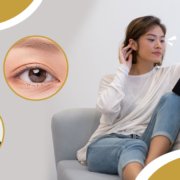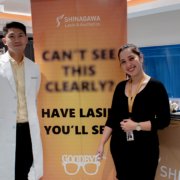Eye Safety Tips for Water Activities
Before you dive in to the water for your next swimming trip, we recommend learning a little about some eye safety considerations that come with water activities (whether you prefer a pool, river, lake, ocean, water park, or backyard Slip N Slide)
Why Water Can Make Your Eyes Burn
Anyone who has opened their eyes underwater at the pool has felt the sting of chloramine. That’s the name of the compound that forms when chlorine binds to contaminants like dirt, oils, and urine that get in the water. It might sound gross, but it’s actually chlorine doing its job and killing the harmful bacteria. Most of the time, chloramine will only cause mild, temporary irritation, and that can also happen if the pH of the pool isn’t balanced.
Keep Your Goggles On
Goggles are a wonderful way to protect your eyes against any contaminants in the water. Find a pair that fits your head well and forms a good seal over your eyes. If they’re so tight that they give you headaches or are so loose that they fall off, that’s no good! It’s even possible to get prescription goggles if you’re going to be spending a lot of time underwater and want to see as clearly as possible.
Leave Your Contacts on Land
A few microorganisms can survive contact with the chlorine in pool water, which is bad news for anyone who wears contact lenses. They act like Petri dishes for these hardy germs, which love moist, warm environments to multiply in. If you do wear contact lenses while swimming, please also wear goggles to reduce the risk of pool water getting on your contacts.
The most dangerous microorganisms living in water are acanthamoeba. While they live in every body of water on the planet, they usually aren’t anything to worry about. However, wearing contacts while swimming gives them much more access to the surface of the eye than they would get otherwise. In the worst case scenario, they burrow into the cornea and cause acanthamoeba keratitis, a condition that can come with permanent blindness.
Even when we leave the germs aside, contacts on their own are a problem in water. They aren’t designed to be submerged, and it could lead to them swelling up and tightening around the cornea, causing irritation, or coming loose and falling out. Overall, it’s safer to leave the contacts at home and stick to glasses and goggles while enjoying the water.
Keep your eyes safe and have fun in the water!
Despite these helpful eye tips, nothing beats having visual freedom when you hit the waters.
LASIK can take away all your visual problems! Schedule your screening now!
For inquiries, questions, and appointments, call our Patient Care Lines:
🖥 Talk to our Consultants via Livechat: https://shinagawa.ph/
📱 Instagram: https://instagram.com/shinagawa_ph/






